
 This costume history information consists of Pages 92-101 of the chapter on the early 14th century dress in the era of Edward The Second 1307 -1327 and taken from English Costume by Dion Clayton Calthrop.
This costume history information consists of Pages 92-101 of the chapter on the early 14th century dress in the era of Edward The Second 1307 -1327 and taken from English Costume by Dion Clayton Calthrop.
For the Introduction to this book see this introduction written by Dion Clayton Calthrop. I have adjusted the images so they are mostly 400 pixels high and can be used for colouring worksheets where pupils add some costume/society facts.
My comments are in italics.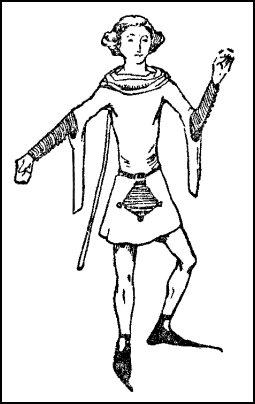
EDWARD THE SECOND
Reigned twenty years: 1307-1327. Born 1284. Married, 1308, Isabella of France.
MEN AND WOMEN
Whether the changes in costume that took place in this reign were due to enterprising tailors, or to an exceptionally hot summer, or to the fancy of the King, or to the sprightliness of Piers Gaveston, it is not possible to say. Each theory is arguable, and, no doubt, in some measure each theory is right, for, although men followed the new mode, ladies adhered to their earlier fashions. Take the enterprising tailor - call him an artist. The old loose robe was easy of cut; it afforded no outlet for his craft; it cut into a lot of material, was easily made at home - it was, in fact, a baggy affair that fitted nowhere. Now, is it not possible that some tailor-artist, working upon the vanity of a lordling who was proud of his figure, showed how he could present this figure to its best advantage in a body-tight garment which should reach only to his hips?Take the hot summer. You may or may not know that a hot summer some years ago suddenly transformed the City of London from a place of top-hats and black coats into a place of flannel jackets and hats of straw, so that it is now possible for a man to arrive at his City office clad according to the thermometer, without incurring the severe displeasure of the Fathers of the City.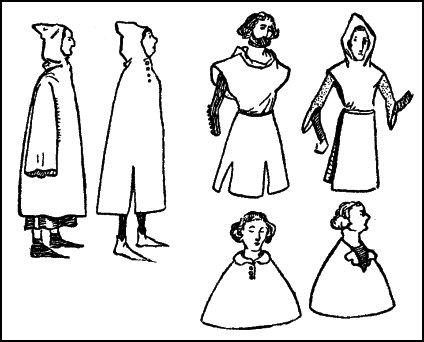
Cotehardies
It seems that somewhere midway between 1307 and 1327 men suddenly dropped their long robes, loosely tied at the waist, and appeared in what looked uncommonly like vests, and went by the name of 'cotehardies.' It must have been surprising to men who remembered England clothed in long and decorous robes to see in their stead these gay, debonair, tight vests of pied cloth or parti-coloured silk. Piers Gaveston, the gay, the graceless but graceful favourite, clever at the tournament, warlike and vain, may have instituted this complete revolution in clothes with the aid of the weak King. Sufficient, perhaps, to say that, although long robes continued to be worn, cotehardies were all the fashion.The Liripipe
There was a general tendency to exaggeration. The hood was attacked by the dandies, and, instead of its modest peak, they caused to be added a long pipe of the material, which they called a 'liripipe.'

The New Cotehardie
This new cotehardie was cut in several ways. Strictly speaking, it was a cloth or silk vest, tight to the body, and close over the hips; the length was determined by the fancy of the wearer. It also had influence on the long robes still worn, which, although full below the waist to the feet, now more closely fitted the body and shoulders. The fashionable sleeves (shown above) were tight to the elbow, and from there hanging and narrow, showing a sleeve belonging to an undergarment.The Cloak
The cloak also varied in shape. The heavy travelling-cloak, with the hood attached, was of the old pattern, long, shapeless, with or without hanging sleeves, loose at the neck, or tightly buttoned. Then there was a hooded cloak, with short sleeves, or with the sleeves cut right away, a sort of hooded surcoat. Then there were two distinct forms of cape: one a plain, circular cape, not very deep, which had a plain, round, narrow collar of fur or cloth, and two or three buttons at the neck; and there was the round cape, without a collar, but with turned back lapels of fur. This form of cape is often to be seen.Accessories
The boots and shoes were longer at the toes, and were sometimes buttoned at the sides. The same form of hats remain, but these were now treated with fur brims. Round the waist there was always a belt, generally of plain black leather; from it depended a triangular pouch, through which a dagger was sometimes stuck.A MAN AND WOMAN OF THE TIME OF EDWARD II - 1307-1327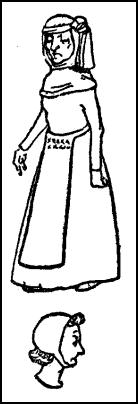
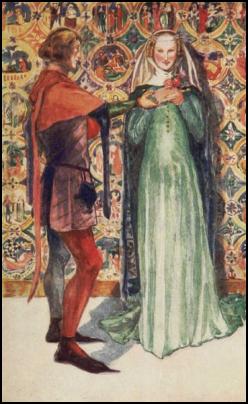
Left - Notice the how long the trailing liripipe on the man's hood is in this era. Observe his short tunic of rayed cloth, the hanging sleeve and his slim fit under-sleeve.
Dressing the hair was important and the woman has her hair dressed in two side-plaits. The throat gorget or neckcloth has been pinned to her plaits.
The time of parti-coloured clothes was just beginning, and the cotehardie was often made from two coloured materials, dividing the body in two parts by the colour difference; it was the commencement of the age which ran its course during the next reign, when men were striped diagonally, vertically, and in angular bars; when one leg was blue and the other red.
You will note that all work was improving in this reign when you hear that the King paid the wife of John de Bureford 100 marks for an embroidered cope, and that a great green hanging was procured for King's Hall, London, for solemn feasts - a hanging of wool, worked with figures of kings and beasts. The ladies made little practical change in their dress, except to wear an excess of clothes against the lack of draperies indulged in by the men.
Dresses - Gowns
It is possible to see three garments, or portions of them, in many dresses.First, there was a stuff gown, with tight sleeves buttoned to the elbow from the wrist; this sometimes showed one or two buttons under the gorget in front, and was fitted, but not tightly, to the figure. It fell in pleated folds to the feet, and had a long train; this was worn alone, we may suppose, in summer. 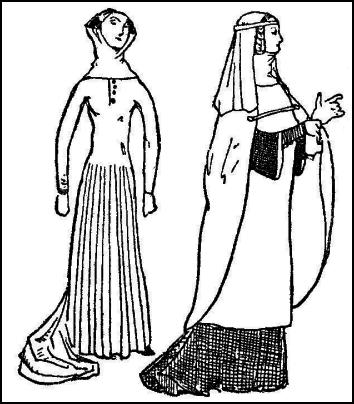
Head Coverings - Wimple, Gorget & Fillet
Upon the head they wore the wimple, the fillet, and about the throat the gorget. The arrangement of the wimple and fillet were new, for the hair was now plaited in two tails, and these brought down straight on either side of the face; the fillet was bound over the wimple in order to show the plait, and the gorget met the wimple behind the plait instead of over it. The older fashion of hair-dressing remained, and the gorget was pinned to the wads of hair over the ears, without the covering of the wimple. Sometimes the fillet was very wide, and placed low on the head over a wimple tied like a gorget; in this way the two side-plaits showed only in front and appeared covered at side-face, while the wimple and broad fillet hid all the top hair of the head.§
Steeple Headdress 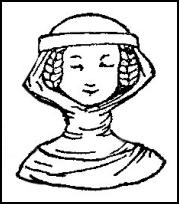
Very rarely a tall, steeple head-dress was worn over the wimple, with a hanging veil; but this was not common, and, indeed, it is not a mark of the time, but belongs more properly to a later date. However, I have seen such a head-dress drawn at or about this time, so must include it.
The semicircular mantle was still in use, held over the breast by means of a silk cord. See more on women's hair in this era.
The Gambeson - Gamboised Garments
It may seem that I describe these garments in too simple a way, and the rigid antiquarian would have made comment on courtepys, on gamboised garments, on cloth of Gaunt, or cloth of Dunster. I may tell you that a gambeson was the quilted tunic worn under armour, and, for the sake of those whose tastes run into the arid fields of such research, that you may call it wambasium, gobison, wambeys, gambiex, gaubeson, or half a dozen other names; but, to my mind, you will get no further with such knowledge.Cyclas & Courtepy
Falding is an Irish frieze; cyclas is a gown; courtepy is a short gown; kirtle - again, if we know too much we cannot be accurate - kirtle may be a loose gown, or an apron, or a jacket, or a riding-cloak.Tabard
The tabard was an embroidered surcoat - that is, a surcoat on which was displayed the heraldic device of the ownerCyclas Let us close this reign with its mournful end, when Piers Gaveston feels the teeth of the Black Dog of Warwick, and is beheaded on Blacklow Hill; when Hugh le Despenser is hanged on a gibbet; when the Queen lands at Orwell, conspiring against her husband, and the King is a prisoner at Kenilworth. Here at Kenilworth the King hears himself deposed. 'Edward, once King of England,' is hereafter accounted 'a private person, without any manner of royal dignity.' Here Edward, in a plain black gown, sees the steward of his household, Sir Thomas Blount, break his staff of office, done only when a King is dead, and discharge all persons engaged in the royal service. Parliament decided to take this strong measure in January; in the following September Edward was murdered in cold blood at Berkeley Castle.EDWARD THE SECOND
Reigned twenty years: 1307-1327. Born 1284. Married, 1308, Isabella of France.
 This costume history information consists of Pages 92-101 of the chapter on the early 14th century dress in the era of Edward The Second 1307 -1327 and taken from English Costume by Dion Clayton Calthrop.
This costume history information consists of Pages 92-101 of the chapter on the early 14th century dress in the era of Edward The Second 1307 -1327 and taken from English Costume by Dion Clayton Calthrop.
Sitemap
- Costume History Home
- Introduction to English Costume by Calthrop
- 1066-1216 Norman
- 1272-1485 Plantagenet
- 1216-1272 Henry III
- 1066-1272 Peasants' Costume - End of the Fourteenth Century
- 1272-1307 Edward I
- 1307-1327 Edward II
- 1327-1377 Edward III
- 1377-1399 Richard II
- 1399-1413 Henry IV
- 1400 Chaucer's Medieval Dress
- 1413-1422 Henry V
- 1422-1461 Henry VI
- 1461-1483 Edward IV
- 1483-1485 Richard III
- 1485-1603 Tudor
- 1603-1714 Stuart
- 1603-1830 Hanover
- Chambre Syndicale
- Theories of Fashion